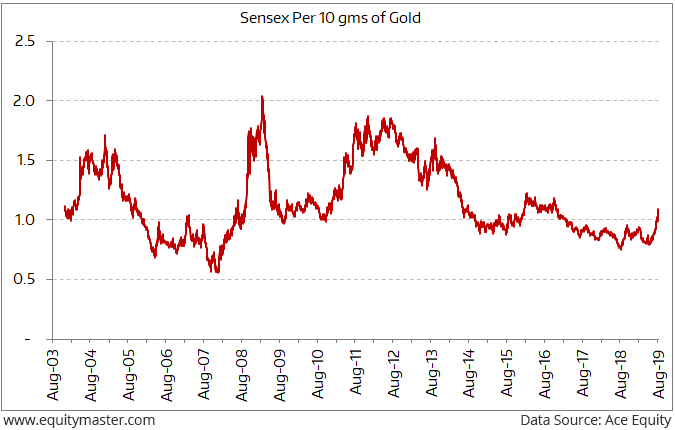India's Third Giant Leap
This Could be One of the Biggest Opportunities for Investors
- Home
- Todays Market
- Indian Stock Market News August 29, 2019
Sensex Opens Over 165 Points Lower; Yes Bank and Tata Steel Top Losers Thu, 29 Aug 09:30 am
Asian share markets are lower today as Chinese and Hong Kong shares fall. The Shanghai Composite is flat while the Hang Seng is down 0.4%. The Nikkei 225 is trading down by 0.5%. US stocks climbed on Wednesday, recovering from early declines on gains in energy and financial shares, but investors remained leery about the potential for another flare-up in the US-China trade war.
Back home, India share markets opened in red. The BSE Sensex is trading down by 165 points while the NSE Nifty is trading down by 50 points. Both, the BSE Mid Cap index and BSE Small Cap index opened up by 0.1%.
All sectoral indices have opened the day on a negative note with metal stocks and Telecom stocks witnessing maximum selling pressure.
The rupee is currently trading at 71.80 against the US$.
The rupee declined by 29 paise to close at 71.77 against the US dollar on Wednesday as fears of an impending global recession prompted investors to stick to safe-haven assets like the Japanese yen.
Reportedly, rising crude oil prices and weakness in the equity market put further pressure on the domestic currency.
At the interbank foreign exchange market, the rupee opened on the back foot at 71.50 a dollar and went on to touch the day's low of 71.87. It finally pared some losses to settle at 71.77, down by 29 paise against its previous close.
On Tuesday, the rupee had zoomed 54 paise to finish at 71.48.
Speaking of currencies, Vijay Bhambwani, editor of Weekly Cash Alerts, tells you the main reasons why not to trade commodities and currencies the same way you would trade equities. Here's an excerpt of what he wrote...
- Currencies are traded in pairs and the most liquid is the USDINR. Currencies are traded in four decimal points just as bonds are. The international derivative trader's association has indicated that forex may be traded in 6 decimals in the coming few years.
It takes months sometimes for the currency pair to pass the next round figure, say from 70 to 71.
Can you really trade commodities and currencies alike or for that matter, equities and currencies alike? Definitely not!
To know more, you can read Vijay's entire article here: Is Trading in Equities, Commodities, and Currencies the Same?
Speaking of the economy as a whole, Richa Agarwal reveals her investing strategy amid all gloom and doom.
She also talks about the stock she is looking at in such times. She is very cautious in her approach and looks for the stocks that survive in all the market cycles.
Tune in to find out...
Moving on to the news from the commodities space. Resuming its record-setting streak, gold price jumped Rs 300 on Wednesday to a fresh all-time high of Rs 39,970 per 10 gm on higher demand from local jewellers and the yellow metal's appeal as safe-haven amid global economic concerns.
Silver sky rocketed Rs 2,110 to Rs 48,850 a kg, helped by positive trend overseas and strong demand from industrial units and coin makers. In the US market, the white metal was trading 0.6% up at US$18.38 an ounce.
Globally, the yellow metal was almost flat at US$1,543 an ounce in New York.
Reportedly, higher uptake by local jewellers ahead of festive season and investors preferring the yellow metal as a safe-haven asset helped the yellow metal touch its new all-time high level.
Gold got a boost as the US yield curve inversion deepened on Tuesday to levels not seen since 2007, which sent US markets sharply lower amid deeper worries about the global economy.
Apart from concerns about global slowdown and worries that a US-China trade breakthrough is not happening soon, gold prices have a boost from buying from central banks.
As many central banks diversify their portfolio, they are adding gold as global growth slows and trade and geopolitical tensions rise.
Speaking of Gold, co-head of research, Tanushree Banerjee shares some interesting information on the Sensex to Gold (per 10 grams) ratio going back 15 years.
Have a look at the chart below:
Sensex versus Gold in Fairly Valued Zone
Here's what she wrote about it in today's edition of The 5 Minute WrapUp...
- While the ratio has been quite volatile, the average ratio turns out to be 1.
In other words, whenever the Sensex has risen at a much faster pace than gold prices, its fall has also been equally precipitous. The reason behind this volatility is not hard to find.
Stock markets are more amenable to manipulation than gold prices are.
Thus, if the Sensex to gold price ratio is way more than one, it could be a signal the Sensex is overvalued.
Alternatively, if it is way below one, it could mean that Sensex is undervalued.
The ratio stands at around 1.09 currently, indicating that the Sensex is trading pretty close to its fair value!
Thus, even though the market correction seems overdone in mid and smallcaps, the bluechips, particularly those in the Sensex, aren't undervalued yet.
To know what's moving the Indian stock markets today, check out the most recent share market updates here.
For information on how to pick stocks that have the potential to deliver big returns, download our special report now!
Read the latest Market Commentary



Equitymaster requests your view! Post a comment on "Sensex Opens Over 165 Points Lower; Yes Bank and Tata Steel Top Losers". Click here!
Comments are moderated by Equitymaster, in accordance with the Terms of Use, and may not appear
on this article until they have been reviewed and deemed appropriate for posting.
In the meantime, you may want to share this article with your friends!